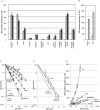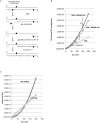Processing closely spaced lesions during Nucleotide Excision Repair triggers mutagenesis in E. coli
- PMID: 28686598
- PMCID: PMC5521853
- DOI: 10.1371/journal.pgen.1006881
Processing closely spaced lesions during Nucleotide Excision Repair triggers mutagenesis in E. coli
Abstract
It is generally assumed that most point mutations are fixed when damage containing template DNA undergoes replication, either right at the fork or behind the fork during gap filling. Here we provide genetic evidence for a pathway, dependent on Nucleotide Excision Repair, that induces mutations when processing closely spaced lesions. This pathway, referred to as Nucleotide Excision Repair-induced Mutagenesis (NERiM), exhibits several characteristics distinct from mutations that occur within the course of replication: i) following UV irradiation, NER-induced mutations are fixed much more rapidly (t ½ ≈ 30 min) than replication dependent mutations (t ½ ≈ 80-100 min) ii) NERiM specifically requires DNA Pol IV in addition to Pol V iii) NERiM exhibits a two-hit dose-response curve that suggests processing of closely spaced lesions. A mathematical model let us define the geometry (infer the structure) of the toxic intermediate as being formed when NER incises a lesion that resides in close proximity of another lesion in the complementary strand. This critical NER intermediate requires Pol IV / Pol II for repair, it is either lethal if left unrepaired or mutation-prone when repaired. Finally, NERiM is found to operate in stationary phase cells providing an intriguing possibility for ongoing evolution in the absence of replication.
Conflict of interest statement
The authors have declared that no competing interests exist.
Figures






Similar articles
-
(5'S)-8,5'-cyclo-2'-deoxyguanosine is a strong block to replication, a potent pol V-dependent mutagenic lesion, and is inefficiently repaired in Escherichia coli.Biochemistry. 2011 May 17;50(19):3862-5. doi: 10.1021/bi2004944. Epub 2011 Apr 25. Biochemistry. 2011. PMID: 21491964 Free PMC article.
-
Nucleotide excision repair or polymerase V-mediated lesion bypass can act to restore UV-arrested replication forks in Escherichia coli.J Bacteriol. 2005 Oct;187(20):6953-61. doi: 10.1128/JB.187.20.6953-6961.2005. J Bacteriol. 2005. PMID: 16199565 Free PMC article.
-
Mechanisms employed by Escherichia coli to prevent ribonucleotide incorporation into genomic DNA by Pol V.PLoS Genet. 2012;8(11):e1003030. doi: 10.1371/journal.pgen.1003030. Epub 2012 Nov 8. PLoS Genet. 2012. PMID: 23144626 Free PMC article.
-
Postreplication repair mechanisms in the presence of DNA adducts in Escherichia coli.Mutat Res. 2011 May-Jun;727(3):104-22. doi: 10.1016/j.mrrev.2011.04.003. Epub 2011 May 5. Mutat Res. 2011. PMID: 21558018 Review.
-
DNA polymerase zeta and the control of DNA damage induced mutagenesis in eukaryotes.Cancer Surv. 1996;28:21-31. Cancer Surv. 1996. PMID: 8977026 Review.
Cited by
-
Aberrant repair initiated by the adenine-DNA glycosylase does not play a role in UV-induced mutagenesis in Escherichia coli.PeerJ. 2018 Dec 5;6:e6029. doi: 10.7717/peerj.6029. eCollection 2018. PeerJ. 2018. PMID: 30568855 Free PMC article.
-
Visualizing mutagenic repair: novel insights into bacterial translesion synthesis.FEMS Microbiol Rev. 2020 Sep 1;44(5):572-582. doi: 10.1093/femsre/fuaa023. FEMS Microbiol Rev. 2020. PMID: 32556198 Free PMC article. Review.
-
Directed evolution of Escherichia coli with lower-than-natural plasmid mutation rates.Nucleic Acids Res. 2018 Sep 28;46(17):9236-9250. doi: 10.1093/nar/gky751. Nucleic Acids Res. 2018. PMID: 30137492 Free PMC article.
-
A Comprehensive View of Translesion Synthesis in Escherichia coli.Microbiol Mol Biol Rev. 2020 Jun 17;84(3):e00002-20. doi: 10.1128/MMBR.00002-20. Print 2020 Aug 19. Microbiol Mol Biol Rev. 2020. PMID: 32554755 Free PMC article. Review.
-
Coordination between nucleotide excision repair and specialized polymerase DnaE2 action enables DNA damage survival in non-replicating bacteria.Elife. 2021 Apr 15;10:e67552. doi: 10.7554/eLife.67552. Elife. 2021. PMID: 33856342 Free PMC article.
References
-
- Reardon JT, Sancar A. Nucleotide Excision Repair Progress in nucleic acid research and molecular …. Elsevier; 2005. pp. 183–235. doi: 10.1016/S0079-6603(04)79004-2 - DOI - PubMed
-
- Li C-L, Golebiowski FM, Onishi Y, Samara NL, Sugasawa K, Yang W. Tripartite DNA Lesion Recognition and Verification by XPC, TFIIH, and XPA in Nucleotide Excision Repair. Mol Cell. 2015;59: 1025–1034. doi: 10.1016/j.molcel.2015.08.012 - DOI - PMC - PubMed
-
- Staresincic L, Fagbemi AF, Enzlin JH, Gourdin AM, Wijgers N, Dunand-Sauthier I, et al. Coordination of dual incision and repair synthesis in human nucleotide excision repair. EMBO J. 2009;28: 1111–1120. doi: 10.1038/emboj.2009.49 - DOI - PMC - PubMed
-
- Novarina D, Amara F, Lazzaro F, Plevani P, Muzi-Falconi M. Mind the gap: keeping UV lesions in check. DNA Repair (Amst). 2011;10: 751–759. doi: 10.1016/j.dnarep.2011.04.030 - DOI - PMC - PubMed
MeSH terms
Substances
LinkOut - more resources
Full Text Sources
Other Literature Sources
Miscellaneous

